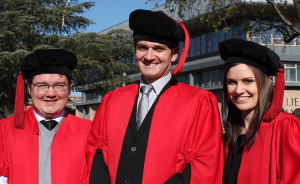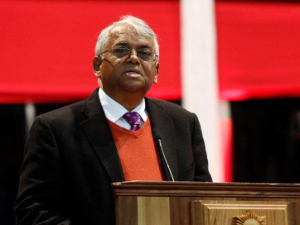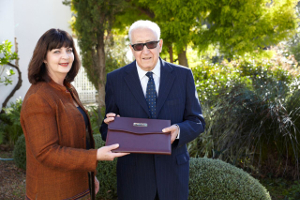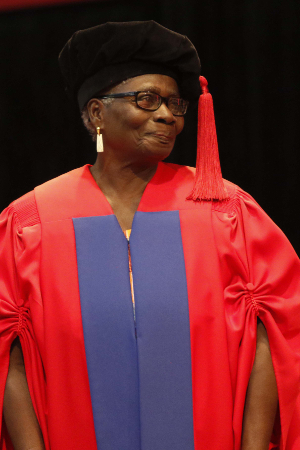Graduates convene with global leaders at the UFS 2015 Winter Graduation ceremonies

Dr Hendrik Auret, dr Gerhard Bosman en dr Madelein Stoffberg.
Foto: Leonie Bolleurs |
|
Photo Gallery
The University of the Free State’s 2015 Winter Graduations, which took place from 1-2 July 2015 on the Bloemfontein Campus offered several highlights. Three global leaders received honorary doctorates. A further 2 000 degrees and diplomas were conferred to graduates in the seven faculties of the university.
For the first time in the history of the UFS, three PhDs in Architecture were awarded simultaneously. Hendrik Auret, Gerhard Bosman, and Madelein Stoffberg’s outstanding achievements are a milestone in the university’s pursuit of academic excellence.
Furthermore, three PhDs were conferred on graduates from the Department of Consumer Science in the Faculty of Natural and Agricultural Sciences. Ismari van der Merwe, Natasha Cronje, and Gloria Seiphetlheng set a precedent when they walked across the Callie Human stage to collect their doctorates at the same graduation ceremony.
This year, the university produced 66 Doctors of Philosophy in various fields of study. Six of these PhDs were awarded in the Department of Physics.
Three graduates in the Department of Soil- and Crop- and Climate Sciences received PhDs at the Winter Graduation. They are Tesha Mardamootoo, Elmarie Kotzé, and David Chemei.

Dr John Samuel.
Photo: Johan Roux |
Keynote speakers provide enlightenment to graduates
On Wednesday 1 July 2015, Dr John Samuel, SA’s leading education expert, addressed 707 diploma graduates from the Centre for Financial Planning Law and the School of Open Learning. For the graduates’ future reference, Samuel offered invaluable knowledge he had accumulated over the years as Chief Executive of the Nelson Mandela Foundation. “One of the lessons I have learnt was not only the importance of time, but it was in fact what being on time demonstrated,” he said. “Being on time was demonstrating respect, respect for the people you are meeting, and for the occasion.”
On the second day of graduation, Nataniël, South African singer, songwriter, and entertainer spoke to Master’s and doctoral graduates in the Faculties of Economic and Management Sciences, Humanities, Education, Health Sciences, Law, Theology, and Natural and Agricultural Sciences. His keynote spoke to the graduates’ sense of resolve in saying, “nothing is ever accidental. It is always with a purpose, it is your turn to make the world a better place.” He added that “it is important to strive for excellence and to be proud of what you are doing.”
Honorary doctorate recipients in a nutshell
Dr Samuel is one of the three exceptional global leaders to receive honorary doctorates from the university on 1 July 2015. His accolade was presented by the Faculty of Education. He has contributed to the Public Participation Education Network (PPEN) campaign as a founding member. He established the Centre for Education Policy Development, the Joint Working Group (for The National Party Government and the ANC), the National Education Conference, and the National Education and Training Forum. In addition, he made leadership contributions to the First Education and Training White Paper, the first Green Paper on Higher Education, and is the CEO of the Oprah Winfrey Leadership Academy for Girls. The WK Kellogg Foundation in the USA operates under his directorship.

Professor Heidi Hudson, Director of the Centre for Africa Studies at the UFS and Dr Lakhdar Brahimi.
Photo: Mike Rose from Mike Rose Photography |
Dr Lakhdar Brahimi received an honorary doctorate from the Centre for Africa Studies. Algerian-born Brahimi was first involved with the United Nations (UN) in 1992, and has since been deployed all over the world on peacekeeping missions. Amongst many other countries, he has worked as a mediator for South Africa, Haiti, Afghanistan, Iraq, Syria, Democratic Republic of Congo, Cameroon, Burundi, Angola, Liberia, Nigeria, Sudan, and Côte d’Ivoire on behalf of the UN. He also played a direct role in South Africa’s democratic transition as a special representative in 1993/4.
Dr Mercy Amba Oduyoye received an honorary doctorate from the Faculty of Theology. Dr Oduyoye is widely regarded as one of the most influential women theologians in Africa. She was the first black woman to receive a degree in Theology in 1965 from Cambridge University in the United Kingdom. She continues to shift the paradigm of gender in theology internationally as the director of the Institute of African Women in Religion and Culture at the Trinity Theology Seminary in Ghana.

Dr Mercy Oduyoye.
Photo: Johan Roux |
In closing the academic celebrations
Vice Rector: Academic, Dr Lis Lange, commended the class of 2014 for making their contribution to the educational system. Prof Jonathan Jansen, Vice Chancellor and Rector, also congratulated the graduates in closing.
“This is a day many have worked very hard towards, it is an enormous achievement as well as a development in the quality of research, and the courage to research,” he said in a vote of confidence.
Dr Khotso Mokhele, Chancellor of the UFS, applauded the university in light of the increased number of female graduates who completed their degrees with distinctions. The transcendence of demographics, both in terms of gender and race, on a postgraduate level, increases the hope of achieving gender equality in both the academic arena and South Africa.
More graduation news
A number of distinctions were also awarded during the two-day ceremony. For a list of these distinctions, follow this link.